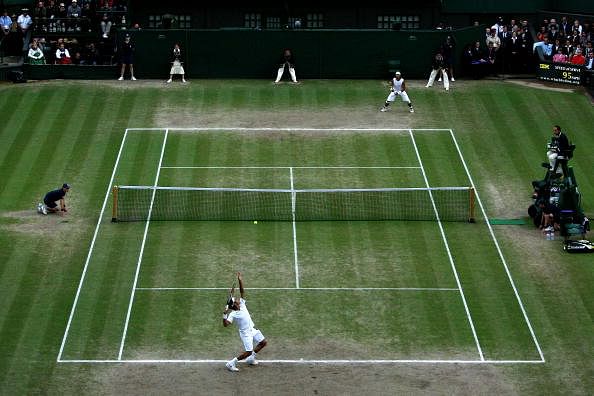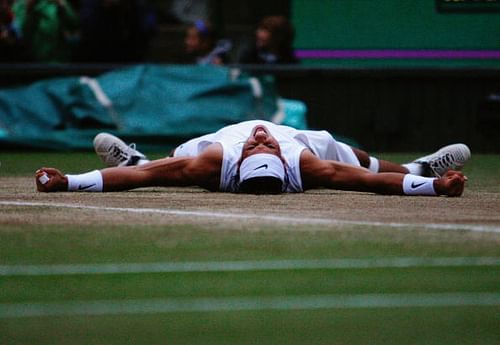
A page from history - the Wimbledon men's singles final, 2008
“If you can meet with triumph and disaster and treat those two impostors just the same.”- Rudyard Kipling

Never has the quote, which sits over Centre Court, fleetingly visible to every man and woman who seeks inimitable glory at the Mecca of tennis just before they step onto the hallowed grounds at Wimbledon, rung truer than the day of the men’s singles final in 2008.
I was in my 3rd year of graduation and one thing that I had learnt about following sports and having heroes was that you hold on, no matter what. Indeed, Kolkata Knight Riders had finished all but at the bottom of the table in the inaugural edition of the IPL not long back, but my real concerns lay elsewhere. Steadily, there seemed to be a shift in world order as far as tennis was concerned, or at least that’s what experts and the media would have me believe. The results of the two Grand Slams before Wimbledon that year had certainly raised quite a few eyebrows. Indeed the master (read Federer) had shown signs that there might be a human side to him on the court after all. In January earlier that year, a young, ruthless Serb (who had issues with his fitness and temperament himself) had crushed his hopes of a fourth Australian title with a resounding straight sets victory inside the revered Rod Laver Arena.
The fact that the Serb went on to win his maiden Major title by defeating the wily Frenchman Jo Wilfried Tsonga fades in the face of the fact that Federer had been pushed out of a Grand Slam event before the finals after three long years. The more interesting fact was that the last time that had happened was in 2005 when a young Rafael Nadal had just started showing off his claycourt prowess. The difference was, however, very clear to the trained eye. Federer was in the formative years of his supremacy in 2005, whereas in 2008, he was supposed to be at the top of his game. Had the great man underestimated his young opponent, or was it the apparent decline of his own game? The questions had to be asked, no matter how much every Federer fan dreaded the answers.
The clay court season brought more sorrow, as he got steamrolled at Roland Garros by now-legendary foe Rafael Nadal in the finals. Even Nadal himself would probably have found it difficult to believe how easily he had won – in straight sets. To add to the ignominy of losing, Federer suffered an injury to add to the insult. Truth be told, it was not really a match. Federer felt that day what many of his opponents had felt from the other side of the court, playing him in the past. The magic wand wasn’t working anymore. The feet were not moving like they used to. Errors were flowing from both sides. The collective gasps from the stunned audience gradually turned into groans as the match moved towards its imminent conclusion. Had the era of Federer, and with that the time of beautiful tennis, finally come to an end? As a die-hard fanatic of the man in question, it was all a nightmare.
The evening of July 8, 2008 was just like any other, but for one reason. It was time for the master and his followers to question destiny. The day of reckoning had finally arrived. The lineup for the finals was a mouth-watering 3rd consecutive clash of the titans on grass. It was Federer’s favorite surface, one on which he had recorded five of his earlier Grand Slam conquests. He was almost invincible on the fast grasscourts which suited his aggressive style of play. Nadal, on the other hand, had a point to prove himself. He was looking to overcome the claycourt stereotype that had surrounded him and this was the perfect stage. Federer had won in 2006 and 2007 in tight matches against him, but he was riding on the commanding victory he had achieved in Paris two weeks ago. The tension in the air was very palpable. The prize could not be any higher. Immortality beckoned.
The start to the spectacle was a dampener, with the match getting underway 35 minutes beyond schedule because of rain. This was the last year in which rain impacted tennis at the All England tennis club, for the next year saw the introduction of the roof on top of Centre Court.

The first set passed the defending champion by very quickly, with Nadal wrapping it up 6-4 after saving three break points en route. The second set looked to be a one-sided affair as well, after Federer took a 4-1 lead, but Nadal, the fighter that he is, took the next five games to win the set 6-4. All of a sudden, the defending champion was staring down the barrel of the gun. This was fast turning into a repeat of the Roland Garros debacle and something had to change quickly for Federer to have any kind of chance in the match. As the third set progressed into the business end, the rain gods decided that they wanted more of a say in the match. The duel was interrupted for a good 80 minutes, before it resumed at Nadal serving to stay in the set at 4-5. Federer used all his guile to take the set 7-5 in the tie-breaker, but it was clearly much closer than he would have wanted it to be.
The fourth set, in its wake, brought some of the best tennis that the world had ever seen on a tennis court. Both players were, by this time, functioning on a different level and exchanging blows like a couple of prizefighters in the ring. Almost as if it was out of the script of a Bollywood potboiler, the set went into a tie-breaker, the last the match could go into. What followed was a maddening rush of adrenaline; tennis of superlative order by two men who just would not accept defeat. The first point of the tie-breaker was a harbinger in itself of what was to come next as the players ran all around the court. Federer took that point, but Nadal raced to a 5-2 lead before the great man staged an epic comeback, only to squander away a set point with an errant forehand.
The last stages of the set saw Nadal and Federer hit two of the most unbelievable passing shots in the match; only, Federer did it off a single-handed backhand in the extreme corner. The roar when the crowd realized that the match was going into a fifth and final decider, was deafening. At this point, the television sets in our hostel went blank. In all the excitement, we had completely forgotten about the ill-conceived rules of the administration about TV hours. When all the coaxing and cajoling didn’t work, all that was left to be done was following the match online. How dramatic, I thought.
Turned out though, there were more theatrics planned by the weather itself as rain came again at the final set tied at 2-2. Everybody assumed by this time that the match was going into Monday, but after the showers had passed 30 minutes later, the organizers decided to give the rain a run for its money by deciding to go on with the match. The topsy-turvy nature continued, till Nadal finally broke through at 7-7. A few minutes later, he had dethroned the master from his coveted throne and he celebrated in his signature style, this time on the green grass though.
As Nadal claimed glory, biting at his spoils, Federer looked on, seemingly unfazed amid the flashing lights of the cameras all around. The quality of tennis played easily trumped the actual result that day. At 4 hours and 48 minutes, it was the longest singles final ever played at Wimbledon and was a career-defining moment for both players. It strongly established Nadal as a prime contender on surfaces other than clay and for Federer, more than anything else, it proved that he was still one of the very best in business. For every Federer and Nadal fan, that match is an epic memory; one that gave each of us an opportunity to witness history being created. It forms the backdrop of every conversation about their cherished rivalry that will ever happen and beyond that, makes us proud to be their devout followers.